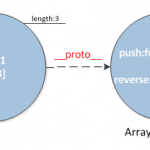Javascript 面向对象编程
Javascript是一个类C的语言,他的面向对象的东西相对于C++/Java比较奇怪,但是其的确相当的强大,在 Todd 同学的“对象的消息模型”一文中我们已经可以看到一些端倪了。这两天有个前同事总在问我Javascript面向对象的东西,所以,索性写篇文章让他看去吧,这里这篇文章主要想从一个整体的角度来说明一下Javascript的面向对象的编程。(成文比较仓促,应该有不准确或是有误的地方,请大家批评指正)
另,这篇文章主要基于 ECMAScript 5, 旨在介绍新技术。关于兼容性的东西,请看最后一节。
目录
初探
我们知道Javascript中的变量定义基本如下:
var name = 'Chen Hao';; var email = 'haoel(@)hotmail.com'; var website = 'https://coolshell.cn';
如果要用对象来写的话,就是下面这个样子:
var chenhao = {
name :'Chen Hao',
email : 'haoel(@)hotmail.com',
website : 'https://coolshell.cn'
};
于是,我就可以这样访问:
//以成员的方式 chenhao.name; chenhao.email; chenhao.website; //以hash map的方式 chenhao["name"]; chenhao["email"]; chenhao["website"];
关于函数,我们知道Javascript的函数是这样的:
var doSomething = function(){
alert('Hello World.');
};
于是,我们可以这么干:
var sayHello = function(){
var hello = "Hello, I'm "+ this.name
+ ", my email is: " + this.email
+ ", my website is: " + this.website;
alert(hello);
};
//直接赋值,这里很像C/C++的函数指针
chenhao.Hello = sayHello;
chenhao.Hello();
相信这些东西都比较简单,大家都明白了。 可以看到javascript对象函数是直接声明,直接赋值,直接就用了。runtime的动态语言。
还有一种比较规范的写法是:
//我们可以看到, 其用function来做class。
var Person = function(name, email, website){
this.name = name;
this.email = email;
this.website = website;
this.sayHello = function(){
var hello = "Hello, I'm "+ this.name + ", \n" +
"my email is: " + this.email + ", \n" +
"my website is: " + this.website;
alert(hello);
};
};
var chenhao = new Person("Chen Hao", "[email protected]",
"https://coolshell.cn");
chenhao.sayHello();
顺便说一下,要删除对象的属性,很简单:
delete chenhao['email']
上面的这些例子,我们可以看到这样几点:
- Javascript的数据和成员封装很简单。没有类完全是对象操作。纯动态!
- Javascript function中的this指针很关键,如果没有的话,那就是局部变量或局部函数。
- Javascript对象成员函数可以在使用时临时声明,并把一个全局函数直接赋过去就好了。
- Javascript的成员函数可以在实例上进行修改,也就是说不同实例相同函数名的行为不一定一样。
属性配置 – Object.defineProperty
先看下面的代码:
//创建对象
var chenhao = Object.create(null);
//设置一个属性
Object.defineProperty( chenhao,
'name', { value: 'Chen Hao',
writable: true,
configurable: true,
enumerable: true });
//设置多个属性
Object.defineProperties( chenhao,
{
'email' : { value: '[email protected]',
writable: true,
configurable: true,
enumerable: true },
'website': { value: 'https://coolshell.cn',
writable: true,
configurable: true,
enumerable: true }
}
);
下面就说说这些属性配置是什么意思。
- writable:这个属性的值是否可以改。
- configurable:这个属性的配置是否可以改。
- enumerable:这个属性是否能在for…in循环中遍历出来或在Object.keys中列举出来。
- value:属性值。
- get()/set(_value):get和set访问器。
Get/Set 访问器
关于get/set访问器,它的意思就是用get/set来取代value(其不能和value一起使用),示例如下:
var age = 0;
Object.defineProperty( chenhao,
'age', {
get: function() {return age+1;},
set: function(value) {age = value;}
enumerable : true,
configurable : true
}
);
chenhao.age = 100; //调用set
alert(chenhao.age); //调用get 输出101(get中+1了);
我们再看一个更为实用的例子——利用已有的属性(age)通过get和set构造新的属性(birth_year):
Object.defineProperty( chenhao,
'birth_year',
{
get: function() {
var d = new Date();
var y = d.getFullYear();
return ( y - this.age );
},
set: function(year) {
var d = new Date();
var y = d.getFullYear();
this.age = y - year;
}
}
);
alert(chenhao.birth_year);
chenhao.birth_year = 2000;
alert(chenhao.age);
这样做好像有点麻烦,你说,我为什么不写成下面这个样子:
var chenhao = {
name: "Chen Hao",
email: "[email protected]",
website: "https://coolshell.cn",
age: 100,
get birth_year() {
var d = new Date();
var y = d.getFullYear();
return ( y - this.age );
},
set birth_year(year) {
var d = new Date();
var y = d.getFullYear();
this.age = y - year;
}
};
alert(chenhao.birth_year);
chenhao.birth_year = 2000;
alert(chenhao.age);
是的,你的确可以这样的,不过通过defineProperty()你可以干这些事:
1)设置如 writable,configurable,enumerable 等这类的属性配置。
2)动态地为一个对象加属性。比如:一些HTML的DOM对像。
查看对象属性配置
如果查看并管理对象的这些配置,下面有个程序可以输出对象的属性和配置等东西:
//列出对象的属性.
function listProperties(obj)
{
var newLine = "<br />";
var names = Object.getOwnPropertyNames(obj);
for (var i = 0; i < names.length; i++) {
var prop = names[i];
document.write(prop + newLine);
// 列出对象的属性配置(descriptor)动用getOwnPropertyDescriptor函数。
var descriptor = Object.getOwnPropertyDescriptor(obj, prop);
for (var attr in descriptor) {
document.write("..." + attr + ': ' + descriptor[attr]);
document.write(newLine);
}
document.write(newLine);
}
}
listProperties(chenhao);
call,apply, bind 和 this
关于Javascript的this指针,和C++/Java很类似。 我们来看个示例:(这个示例很简单了,我就不多说了)
function print(text){
document.write(this.value + ' - ' + text+ '<br>');
}
var a = {value: 10, print : print};
var b = {value: 20, print : print};
print('hello');// this => global, output "undefined - hello"
a.print('a');// this => a, output "10 - a"
b.print('b'); // this => b, output "20 - b"
a['print']('a'); // this => a, output "10 - a"
我们再来看看call 和 apply,这两个函数的差别就是参数的样子不一样,另一个就是性能不一样,apply的性能要差很多。(关于性能,可到 JSPerf 上去跑跑看看)
print.call(a, 'a'); // this => a, output "10 - a" print.call(b, 'b'); // this => b, output "20 - b" print.apply(a, ['a']); // this => a, output "10 - a" print.apply(b, ['b']); // this => b, output "20 - b"
但是在bind后,this指针,可能会有不一样,但是因为Javascript是动态的。如下面的示例
var p = print.bind(a);
p('a'); // this => a, output "10 - a"
p.call(b, 'b'); // this => a, output "10 - b"
p.apply(b, ['b']); // this => a, output "10 - b"
继承 和 重载
通过上面的那些示例,我们可以通过Object.create()来实际继承,请看下面的代码,Student继承于Object。
var Person = Object.create(null);
Object.defineProperties
(
Person,
{
'name' : { value: 'Chen Hao'},
'email' : { value : '[email protected]'},
'website': { value: 'https://coolshell.cn'}
}
);
Person.sayHello = function () {
var hello = "<p>Hello, I am "+ this.name + ", <br>" +
"my email is: " + this.email + ", <br>" +
"my website is: " + this.website;
document.write(hello + "<br>");
}
var Student = Object.create(Person);
Student.no = "1234567"; //学号
Student.dept = "Computer Science"; //系
//使用Person的属性
document.write(Student.name + ' ' + Student.email + ' ' + Student.website +'<br>');
//使用Person的方法
Student.sayHello();
//重载SayHello方法
Student.sayHello = function (person) {
var hello = "<p>Hello, I am "+ this.name + ", <br>" +
"my email is: " + this.email + ", <br>" +
"my website is: " + this.website + ", <br>" +
"my student no is: " + this. no + ", <br>" +
"my departent is: " + this. dept;
document.write(hello + '<br>');
}
//再次调用
Student.sayHello();
//查看Student的属性(只有 no 、 dept 和 重载了的sayHello)
document.write('<p>' + Object.keys(Student) + '<br>');
通用上面这个示例,我们可以看到,Person里的属性并没有被真正复制到了Student中来,但是我们可以去存取。这是因为Javascript用委托实现了这一机制。其实,这就是Prototype,Person是Student的Prototype。
当我们的代码需要一个属性的时候,Javascript的引擎会先看当前的这个对象中是否有这个属性,如果没有的话,就会查找他的Prototype对象是否有这个属性,一直继续下去,直到找到或是直到没有Prototype对象。
为了证明这个事,我们可以使用Object.getPrototypeOf()来检验一下:
Student.name = 'aaa';
//输出 aaa
document.write('<p>' + Student.name + '</p>');
//输出 Chen Hao
document.write('<p>' +Object.getPrototypeOf(Student).name + '</p>');
于是,你还可以在子对象的函数里调用父对象的函数,就好像C++里的 Base::func() 一样。于是,我们重载hello的方法就可以使用父类的代码了,如下所示:
//新版的重载SayHello方法
Student.sayHello = function (person) {
Object.getPrototypeOf(this).sayHello.call(this);
var hello = "my student no is: " + this. no + ", <br>" +
"my departent is: " + this. dept;
document.write(hello + '<br>');
}
这个很强大吧。
组合
上面的那个东西还不能满足我们的要求,我们可能希望这些对象能真正的组合起来。为什么要组合?因为我们都知道是这是OO设计的最重要的东西。不过,这对于Javascript来并没有支持得特别好,不好我们依然可以搞定个事。
首先,我们需要定义一个Composition的函数:(target是作用于是对象,source是源对象),下面这个代码还是很简单的,就是把source里的属性一个一个拿出来然后定义到target中。
function Composition(target, source)
{
var desc = Object.getOwnPropertyDescriptor;
var prop = Object.getOwnPropertyNames;
var def_prop = Object.defineProperty;
prop(source).forEach(
function(key) {
def_prop(target, key, desc(source, key))
}
)
return target;
}
有了这个函数以后,我们就可以这来玩了:
//艺术家
var Artist = Object.create(null);
Artist.sing = function() {
return this.name + ' starts singing...';
}
Artist.paint = function() {
return this.name + ' starts painting...';
}
//运动员
var Sporter = Object.create(null);
Sporter.run = function() {
return this.name + ' starts running...';
}
Sporter.swim = function() {
return this.name + ' starts swimming...';
}
Composition(Person, Artist);
document.write(Person.sing() + '<br>');
document.write(Person.paint() + '<br>');
Composition(Person, Sporter);
document.write(Person.run() + '<br>');
document.write(Person.swim() + '<br>');
//看看 Person中有什么?(输出:sayHello,sing,paint,swim,run)
document.write('<p>' + Object.keys(Person) + '<br>');
Prototype 和 继承
我们先来说说Prototype。我们先看下面的例程,这个例程不需要解释吧,很像C语言里的函数指针,在C语言里这样的东西见得多了。
var plus = function(x,y){
document.write( x + ' + ' + y + ' = ' + (x+y) + '<br>');
return x + y;
};
var minus = function(x,y){
document.write(x + ' - ' + y + ' = ' + (x-y) + '<br>');
return x - y;
};
var operations = {
'+': plus,
'-': minus
};
var calculate = function(x, y, operation){
return operations[operation](x, y);
};
calculate(12, 4, '+');
calculate(24, 3, '-');
那么,我们能不能把这些东西封装起来呢,我们需要使用prototype。看下面的示例:
var Cal = function(x, y){
this.x = x;
this.y = y;
}
Cal.prototype.operations = {
'+': function(x, y) { return x+y;},
'-': function(x, y) { return x-y;}
};
Cal.prototype.calculate = function(operation){
return this.operations[operation](this.x, this.y);
};
var c = new Cal(4, 5);
c.calculate('+');
c.calculate('-');
这就是prototype的用法,prototype 是javascript这个语言中最重要的内容。网上有太多的文章介始这个东西了。说白了,prototype就是对一对象进行扩展,其特点在于通过“复制”一个已经存在的实例来返回新的实例,而不是新建实例。被复制的实例就是我们所称的“原型”,这个原型是可定制的(当然,这里没有真正的复制,实际只是委托)。上面的这个例子中,我们扩展了实例Cal,让其有了一个operations的属性和一个calculate的方法。
这样,我们可以通过这一特性来实现继承。还记得我们最最前面的那个Person吧, 下面的示例是创建一个Student来继承Person。
function Person(name, email, website){
this.name = name;
this.email = email;
this.website = website;
};
Person.prototype.sayHello = function(){
var hello = "Hello, I am "+ this.name + ", <br>" +
"my email is: " + this.email + ", <br>" +
"my website is: " + this.website;
return hello;
};
function Student(name, email, website, no, dept){
var proto = Object.getPrototypeOf;
proto(Student.prototype).constructor.call(this, name, email, website);
this.no = no;
this.dept = dept;
}
// 继承prototype
Student.prototype = Object.create(Person.prototype);
//重置构造函数
Student.prototype.constructor = Student;
//重载sayHello()
Student.prototype.sayHello = function(){
var proto = Object.getPrototypeOf;
var hello = proto(Student.prototype).sayHello.call(this) + '<br>';
hello += "my student no is: " + this. no + ", <br>" +
"my departent is: " + this. dept;
return hello;
};
var me = new Student(
"Chen Hao",
"[email protected]",
"https://coolshell.cn",
"12345678",
"Computer Science"
);
document.write(me.sayHello());
兼容性
上面的这些代码并不一定能在所有的浏览器下都能运行,因为上面这些代码遵循 ECMAScript 5 的规范,关于ECMAScript 5 的浏览器兼容列表,你可以看这里“ES5浏览器兼容表”。
本文中的所有代码都在Chrome最新版中测试过了。
下面是一些函数,可以用在不兼容ES5的浏览器中:
Object.create()函数
function clone(proto) {
function Dummy() { }
Dummy.prototype = proto;
Dummy.prototype.constructor = Dummy;
return new Dummy(); //等价于Object.create(Person);
}
var me = clone(Person);
defineProperty()函数
function defineProperty(target, key, descriptor) {
if (descriptor.value){
target[key] = descriptor.value;
}else {
descriptor.get && target.__defineGetter__(key, descriptor.get);
descriptor.set && target.__defineSetter__(key, descriptor.set);
}
return target
}
keys()函数
function keys(object) { var result, key
result = [];
for (key in object){
if (object.hasOwnProperty(key)) result.push(key)
}
return result;
}
Object.getPrototypeOf() 函数
function proto(object) {
return !object? null
: '__proto__' in object? object.__proto__
: /* not exposed? */ object.constructor.prototype
}
bind 函数
var slice = [].slice
function bind(fn, bound_this) { var bound_args
bound_args = slice.call(arguments, 2)
return function() { var args
args = bound_args.concat(slice.call(arguments))
return fn.apply(bound_this, args) }
}
参考
- W3CSchool
- MDN (Mozilla Developer Network)
- MSDN (Microsoft Software Development Network)
- Understanding Javascript OOP.
(转载时请注明作者和出处,请勿用于任何商业用途)
(转载本站文章请注明作者和出处 酷 壳 – CoolShell ,请勿用于任何商业用途)







 (31 人打了分,平均分: 4.29 )
(31 人打了分,平均分: 4.29 )
《Javascript 面向对象编程》的相关评论
Get/Set 访问器一节的代码中少个逗号
js为什么要搞OOP呢
this 会误导大家,this和c++的this完全不同
@canjianx
两种语言,不同的架构,设计为什么要把这些定义性规范性的东西拿一块比较呢?
在继承和重载那段示例代码中:
“
Student.name=’aaa’;
document.write(”+Student.name+”);
”
在ff 11中仍然输出’Chen Hao’,chrome则为’aaa’
猜测ff在“Student.name = ‘aaa’”时检测到Person有此属性,而name的writable默认为false,所以修改不成功,
而chrome遇到同样的情况,于是为Student创建了name,并设为‘aaa’
通过listProperties可看出,ff没有为Student创建name,而chrome有
稍作更正,如果Prototype有该属性而对象本身没有,ff会在writable为true时为对象创建属性,false则不会;而chrome则不论writable为true还是false,都会为对象创建属性
看完后,感觉脑袋里的东东好乱啊,看来我没有看明白
学习了,很好很强大,不过兼容性问题是不得不考虑的,css需要用hack也就罢了,难道js也要为不同的浏览器写不同的代码
this和 $有什么不同?
这也是js糟糕的地方,本来图方便,为开发者省时间
但浏览器各自为政,连最根本的语法原理,解释地都不一样.
LZ是高手。
您好,有个问题想请教一下:我在声明对象时使用如下格式
var chenhao = {
name :’Chen Hao’,
email : ‘haoel(@)hotmail.com’
};
和
var chenhao = new Object();
funcion fun1(name, mail){
chenhao = {
name : name,
email : mail
};
…………
}
是否有区别? 我的初衷是新网定义一个全局的对象,因为赋值、使用时在不用的function里,不知道这样是否有什么负作用?
好文。看好javascript。。
Object.defineProperty( chenhao,
‘age’, {
get: function() {return age+1;},
set: function(value) {age = value;}
enumerable : true,
configurable : true
}
);
表示set: function(value) {age = value;}后面少了个”,“号.
// 继承prototype
Student.prototype = Object.create(Person.prototype);
//重置构造函数
Student.prototype.constructor = Student; <—– This is not needed
The second line is not needed because when you copy the prototype, the constructor, which is a member of the prototype, is already copied.
谢谢浩哥的分享,google搜 js面向对象 头条,说明很多人受益匪浅!
“Javascript的成员函数可以在实例上进行修改,也就是说不同实例相同函数名的行为不一定一样”
这句中的‘相同函数名’,是不是改为‘同一个函数’更容易理解?
不兼容es5的proto函数无法替代Student里面代码:
var proto = Object.getPrototypeOf;
proto(Student.prototype).constructor.call(this, name, email, website);
因为重置构造函数Student.prototype.constructor = Student;
Student.prototype.constructor.prototype返回的难道不是Student.prototype么?
建议你把 重载 改为 复写(重写),虽然你这边的重载是想表达复写(重写)的意思。在oo语言中 重载 是指同一个类中同名函数不同参数,而复写(重写)才是用于继承时同名函数的。也不是挑刺了,只是有些概念需要表达清楚一下,希望博主改进一下。
@neevek
[不懂就问]:例子中这么做,是为了把之前的person 的 构造函数 替换成 student的构造函数吧?
prototype拷贝,只是把person的构造函数做了拷贝,而student的构造函数应该也做对应的修改
不知道这么理解的对不对
之前看过类似的,才翻出来此文看了下,如下问题怎么解释呀?
“`javascript
var age = 0;
Object.defineProperty(chenhao, age, {
get: function() { return age + 1; },
set: function(value) { age = value; },
enumerable: true,
configurable: true});
chenhao.age = 100;
console.log(chenhao.age);
“`
chenhao.age 这里调用 get 貌似还是 100喔, 这是为啥?
@Colin
貌似是因为写成了这样: Object.defineProperty(chenhao, age, { … }),
而不是 Object.defineProperty(chenhao, ‘age’, { … });
>chenhao
Object
0: (…)
get 0: function ()
set 0: function (value)
email: “[email protected]”
name: “Chen Hao”
website: “http://coolshell.cn”
http://stackoverflow.com/questions/18524652/how-to-use-javascript-object-defineproperty